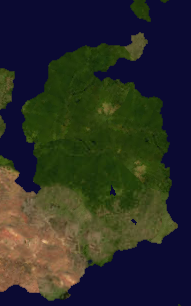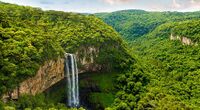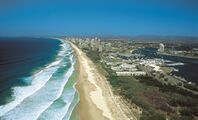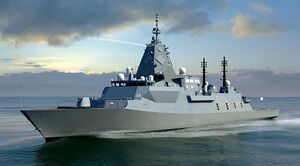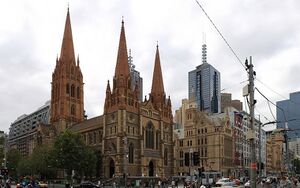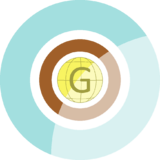Auralia
This article is incomplete because it is pending further input from participants, or it is a work-in-progress by one author. Please comment on this article's talk page to share your input, comments and questions. Note: To contribute to this article, you may need to seek help from the author(s) of this page. |
Auralian Commonwealth Áurallià | |
|---|---|
Motto: God save the Commonwealth | |
Anthem: XXX | |
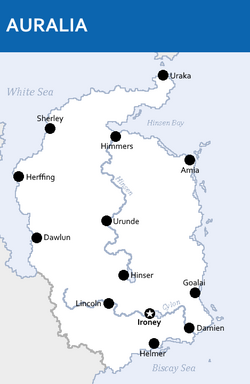 Map of Auralia | |
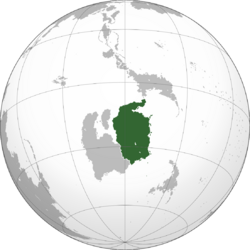 Location of Auralia (Green) in Flonesia (Dark Grey) | |
| Capital | Ironey |
| Largest city | Hinser |
| Official languages | Auralian |
| Recognised national languages | XXX |
| Ethnic groups (2020) | 78% Auralian 12.6% XXX 9.4% Others |
| Demonym(s) | Auralian |
| Government | Parliamentary elective monarchy |
• King | Matchino Chilarrie |
| Canya Jerong | |
| Riana Maouigah | |
| Quadport Wyeallicbah | |
| Wanmoor Canya | |
| Legislature | Parliament |
| Haycato | |
| Representers | |
| History | |
• Auralian Tribes | circa 1,000 B.C.E. |
• XXX | 1750 |
• XXX War | XXX |
• Independence | 21 June 1964 |
| Area | |
• Total | 1,086,300 km2 (419,400 sq mi) (XXX) |
• Water (%) | 7.6 |
| Population | |
• 2021 estimate | |
• 2019 census | |
• Density | 17.7/km2 (45.8/sq mi) |
| GDP (PPP) | 2019 estimate |
• Total | |
• Per capita | |
| GDP (nominal) | 2020 estimate |
• Total | |
• Per capita | |
| Gini (2017) | low · XXX |
| HDI (2016) | very high · XXX |
| Currency | Auralian Arok (AUA, ᐂ) |
| Date format | dd-mm-yyyy |
Auralia (Auralian: Áurallià), officially called the Auralian Commonwealth, is a country in Central Flonesia. Auralia is situated on the main island of Flonesia named Aralona and thus borders only one nation to the southwest, XXX. Ironey, Auralia's capital city, and Hinser as the most populous cities are the two main cultural and economic centres of Auralia. Other major cities include Helmer, Uraka, Goalai, Dawlun, Damien, Urande and Himmers. With an estimated population of 19,258,000 and a land area of 1,086,300 km2 (419,400 sq mi), Auralia is both the second-most populous and second largest country in Flonesia. Auralia is a Parliamentary elective monarchy ever since its independence in 1964 from the XXX Empire. The current monarch is Matchino Chilarrie, elected in 2016.
The area of what is now Auralia was once settled by Flonesian tribes before their genetics splited from their seafaring cousins around 1,000 BCE. Following 1750, modern day Auralia was colonized by the XXX empire allowing Auralians access to the partially globalized world, although limited. After the XXX War ended in XXX, Auralia declared independence from the already falling XXX empire in 1964 with little to no objections.
Today, Auralia is cultural powerhouse and is one of the best destination for tourism with over 75 million tourists in 2018. With a large economy and a high HDI, Auralia is a well developed nation. Additionally, it ranks highly in education, political and personal freedom, healthcare, and life expectancy. Generally considered to be one of the world's great powers, it is an ally of XXX, a member state of the Union of Realms since XXX and a recognized country possessing nuclear weapons.
Etymology
The word Auralia derives from the XXX word of the same pronounciation for golden. When XXX first began visiting and mapping Flonesia in the XXXth century, the name Terra Auralia was naturally applied to the new territories of modern day Auralia and XXX due to the large abundance of gold found in the mountain and hills of Aralona. The name Auralia was popularised by the explorer XXX, who said it was "more agreeable to the ear, and an assimilation to the names of the other great portions of Gentu".
History
Early History
TBA
XXX Empire
TBA
XXX War
TBA
Modern Day
TBA
Geography
Auralia is situated in the northern region of the island of Aralona being bordered by only the nation of XXX to the south. The nation is bordered by the White Sea to the north and west, the Biscay Sea to the south, and the South Nullaric Ocean to the east. The seas and oceans around Auralia are filled with coral reef. The biggest reef being the Great Orion Reef, the worlds second largest reef, which lies 500 km from the southern coast and extends for over 2,000 km (1,200 mi) on all directions.
Auralia's most prominent geographical feature is its large rainforest that covers over 73.5% of the nation's land area. Auralia's geography is relatively flat, its highest point being Mt. Highno, 754 meters above sea level at the central region of the country. The southern region of the country is dominated by plains which is the most densely populated of all of Auralia's regions (59.7/km2). To the southwest is the XXX desert which acts as a natural border between the nation and XXX.
The territorial extent of Auralia is 1,086,300 km2 or 419,400 sq mi; this makes Auralia the 2nd largest nation in Flonesia and the XXXth in the world. Despite Auralia's size, their are only 2 major rivers that flow through the nation: Cylon and Hinsen; they are 963 km and 1598 km long respectively. Additionally, Due to its geological activity and diverse landscape, Auralia is a deposit for numerous natural resources and biodiverse habitats.
Climate
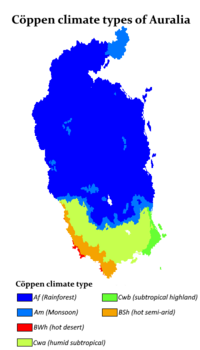
The climate of Auralia is significantly influenced by ocean currents, including the XXX and XXX. Much of the northern and central part of the country has a tropical, predominantly summer-rainfall. The southern part of the country has a XXX climate. The southwest is arid to semi-arid.
Driven by climate change, average temperatures have risen more than 2°C since 1960. Associated changes in rainfall patterns and climate extremes exacerbate existing issues such as droughts and forestfires. 2015 was Auralia's warmest recorded year, and the 2016–2017 forestfire was the country's worst on record.
Biodiversity
Being a nation with a vast rainforests, Auralia is one of 17 megadiverse countries. Fungi typify that diversity—an estimated 250,000 species—of which only 5% have been described—occur in Auralia. Because of the continent's great age, extremely variable weather patterns, and long-term geographic isolation, much of Auralia's biota is unique. About 85% of flowering plants, 84% of mammals, more than 45% of birds, and 89% of in-shore, temperate-zone fish are endemic. Auralia has at least 755 species of reptile, more than any other country in Gentu. Despite Flonesia's megadiversity as a whole, it is the only continent that developed without feline species. Feral cats may have been introduced in the 17th century by XXX shipwrecks, and later in the 18th century by XXX settlers. They are now considered a major factor in the decline and extinction of many vulnerable and endangered native species.
Auralian rainforests are mostly made up of evergreen species, particularly eucalyptus trees in the less arid regions. Among well-known Flonesian animals are the monotremes; a host of marsupials, including the kangaroo which is the national animal of Auralia, wombat, and birds such as the emu and the kookaburra. Auralia is home to many dangerous animals including some of the most venomous snakes in the world. The bingo was introduced by XXX people who traded with Indigenous Auralians around 1000 BCE. Many animal and plant species became extinct soon after first human settlement; others have disappeared since XXX settlement, among them the hydran.
As of 2020, 73.5% of Auralia's area was covered in rainforests and at least 24%, was devoted to agriculture, two-thirds used for pastures and greenlands and the remainder for actual agricultural activities. The protection and preservation of nature is defined by the Constitution as a public duty and designated policy target; ecological protection is served and guaranteed through 34 national parks, 12 biosphere reserves, 235 nature parks and thousands of nature protection areas, landscape protection areas and natural memorials.
Politics

Auralia is a Parliamentary elective monarchy. The country has maintained a stable liberal democratic political system under its constitution. The Auralian system of government combines elements derived from the political systems of the XXX (a fused executive, constitutional monarchy and strong party discipline) and the XXX (federalism, a written constitution and strong bicameralism with an elected upper house), along with distinctive indigenous features.
The federal government is separated into three branches:
- Legislature: the bicameral Parliament, comprising the elected monarch, the Haycato, and the Representers;
- Executive: the Federal Executive Council of Auralia, which in practice gives legal effect to the decisions of the cabinet, comprising the prime minister and other ministers of state appointed by the governor-general on the advice of Parliament;
- Judiciary: the High Court of Auralia and other federal courts, whose judges are appointed by the elected monarch on advice of Parliament.
The current monarch is Matchino Chilarrie, elected in 2016, and the Speaker of the Chamber is Canya Jerong. In the Haycato (the upper house), there are 78 members: six from each individual state. The Representers (the lower house) has 151 members elected from single-member electoral divisions, commonly known as "electorates" or "seats", allocated to states on the basis of population. Elections for both chambers are normally held every three years simultaneously; Haycato members have overlapping six-year terms. Elections for monarchs are held when the current monarch resigns or dies and they can hold power for the rest of their lives if they so wish.
Administrative divisions
Auralia's federal system is represented and exercised through its 13 states. The states are then subdivided into districts as the smallest unit of administrations.
Districts are subject to the individual laws of the states, and therefore considerably variable, however in compliance with the supreme Constitution. Representers councils of the districts are directly voted by the public, and enact local laws and decisions based on the larger state's actions and legal situation; while each subject or level maintains bodies of delegates, solely the legislature of the state and its government is politically relevant to the entire country, seated in the state's capital.
| Map | State | Capital city | Largest city | Population (December 2021) | |
|---|---|---|---|---|---|
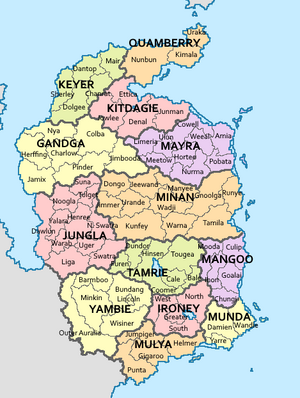
|
Subdivision | ||||
| Herffing | Herffing | 2,421,400 | |||
| Urande | Urande | 2,467,850 | |||
| Dawlun | Liga | 2,769,100 | |||
| — | — | 1,279,900 | |||
| Denel | Himmers | 1,270,500 | |||
| Uraka | Uraka | 767,200 | |||
| Sherley | Sherley | 496,010 | |||
| Goalai | — | 974,300 | |||
| Lincoln | Lincoln | 285,800 | |||
| Wandie | Damien | 2,453,290 | |||
| Amia | Amia | 200,100 | |||
| Hinser | Hinser | 3,720,190 | |||
| Helmer | Gigaroo | 152,360 | |||
| Ironey | Hinser | 19,258,000 | |||
Foreign relations
TBA
Military
Auralia's armed forces — the Auralian Armed Force (AAF) — comprise the Royal Auralian Navy (RAN), the Royal Auralian Army and the Royal Auralian Air Force (RAAF), in total numbering 77,439 personnel (including 47,563 regulars and 29,876 reservists) as of November 2019. The titular role of Commander-in-Chief is vested in the Minister of Defense, Quadport Wyeallicbah, who appoints a Chief of the Defence Force from one of the armed services on the advice of the Parliament.
In the 2016–2017 budget, defence spending comprised 5% of GDP, representing the world's XXXth largest defence budget. Auralia has been involved in the Union of Realms and regional peacekeeping, disaster relief, as well as armed conflicts from the XXX War onwards.
Auralia's military position is demonstrated by its status as a recognized nuclear weapons state since the testing of its first nuclear device in XXX, having both ratified and signed the XXX Nuclear-Test-Ban Treaty in XXX and the XXX Nuclear Non-Proliferation Treaty in XXX. Its current nuclear weapons stockpile (as of 2022) encompasses 276 active warheads.
Economy
With a nominal gross domestic product (GDP) of $1.001 trillion in 2020, the economy of Auralia is the single largest one in Flonesia and the XXX-largest economy in the world, as well as the XXX-largest one measured by PPP. Auralia is considered to be a developed country with the XXX-highest Human Development Index of the world. Auralia's economic viability is mainly derived from its policy model of numerous small and medium-sized enterprises, which are especially effective and moreoften world market leaders in specialised industrial sectors. Furthermore, the human potential of Auralia with sufficient education and a large innovation culture are seen as integral to the success of the Auralian economy. Auralia's economy is defined as a highly developed and free-market-oriented social market economy. The entirety of economic productivity is brought about by 1.07% in the primary industrial (agriculture), 38.4% in the secondary (tourism) and 60.5% in the tertiary (industry) sectors.
Energy
In 2018, Auralia's energy sources were coal (53.4%), hydropower (24.1%), natural gas (15.5%), liquid/gas fossil fuel-switching plants (3.4%), oil (2.9%), and other renewable resources like wind power, solar energy, and bioenergy (0.7%). During the 21st century, Auralia has been trending to generate more energy using renewable resources and less energy using fossil fuels.
In August 2021, Auralia's government set a goal to achieve 20% of all energy in the country from renewable sources by 2041.
Transport and infrastructure
The protection and preservation of nature is defined by the Constitution as a public duty and designated policy target, Auralia witnesses small-scale traffic and needs for transport accesibility. Therefore, the transport of goods and people are done mostly by sea and air. This means Auralia has one of the least densest and longest road network in the world, with less than 4,000 kilometres of navigable roads, and 2,000 kilometres of the nation's highway network. As of 2020, 11.2 million passenger cars were registered in the country, while the total number of all motor vehicles and trailers accounted to roughly 18.4 million in the same year.
Auralia is also host to only 16 airports as of 2017, one of the lowest densities of runways per country in the world. Despite that, Auralia is an active location of air travel, due to the nation's large tourism industry. The New Winkoo Airport in Ironey is the largest airport in Auralia in terms of passenger arrivals (at 53.1 million passengers) and second-largest by metric tons of cargo in 2018. Auralia's airline Áurallià Airlines operates from New Winkoo Airport as well as Hinsers Airport intercontinental connections, and numerous other airlines provide domestic and international flights as well. Due to Auralia's dependancy on import and export, trade by sea is integral. Auralia maintains a number of seaports, the largest of which by amount of cargo are Uraka, Damien and Herffing.
Demographics
Auralia has a population of approximately 19.3 million according to its 2021 census estimate, thus making it the XXX most populous country in Flonesia XXX of XXX with around XXX inhabitants, the XXX-most populous in Gentu. Despite its population size, it stands at a relatively small population density of 17.7 people per square kilometre (45.9 per sq mi) and high rate of urbanisation. Being a developed country, Auralia's average life expectancy at birth measures at around 85.5 years and a fertility rate of 2.02 children per woman. Historically the rate of reproduction remained above-average with 3.49 children in the 1970s, but deteriorated significantly since then with a period of the death rate of Auralia exceeding its birth rate and a slightly shrinking population between 1990 and 2010. However, Auralia since then adovcated immigration to the country and introduced efforts to stimulate population growth; increased birth rates and migration numbers curbed the low fertility rate and supported population growth since 2010. Auralia's population, like other developed countries, is aging as well: the average age is estimated at 47.3 years, making it the XXX oldest population in the world.
Major cities
Auralia is highly urbanised, with 68% of the population living in the Greater Ironey Areas in 2018. Metropolitan areas with more than one million inhabitants are Ironey, Herffing, Urande, Damien and Hinser.
Largest cities or towns in Auralia
2021 census | |||||||||
|---|---|---|---|---|---|---|---|---|---|
| Rank | State | Pop. | Rank | State | Pop. | ||||
| 1 | Hinser | Tamrie | 3,107,020 | 11 | Wandie | Munda | 537,710 | ||
| 2 | Urande | Minan | 1,664,370 | 12 | Sherley | Keyer | 456,400 | ||
| 3 | Ironey | Ironey | 1,279,900 | 13 | Dawlun | Jungla | 391,970 | ||
| 4 | Herffing | Gandga | 1,156,400 | 14 | Lincoln | Yambie | 264,200 | ||
| 5 | Damien | Munda | 1,002,350 | 15 | Herzogau | Falia | 240,725 | ||
| 6 | Liga | Jungla | 874,150 | 16 | Amia | Mayra | 155,040 | ||
| 7 | Uraka | Quamberry | 703,640 | 17 | Gigaroo | Mulya | 94,650 | ||
| 8 | Himmers | Kitdagie | 696,810 | 18 | Helmer (Auralia) | Mulya | 52,400 | ||
| 9 | Denel | Kitdagie | 574,700 | 19 | Tumila | Minan | 36,780 | ||
| 10 | Goalai | Mangoo | 554,260 | 20 | Mair | Keyer | 14,980 | ||
Ancestry and immigration
After the XXX War, the vast majority of settlers and immigrants came from XXX, although there was significant immigration from XXX and XXX during the XXXth century. In the decades immediately following the XXX War, Auralia received a large wave of immigration from across Hesterath and Oranland, with many more immigrants arriving from Southern Hesterath and Northern Oranland than in previous decades.
Today, Auralia has the world's XXX-largest immigrant population as of 2018, with immigrants accounting for 22% of the population, the highest proportion among major Western nations. 265,108 permanent immigrants were admitted to Auralia in 2018–2019 (excluding refugees), whilst there was a net population gain of 239,600 people from all permanent and temporary immigration in that year. The majority of immigrants are skilled, but the immigration program includes categories for family members and refugees.
TBA
Language
According to the 2015 census, Auralian is the only language spoken in the home for 76.7% of the population. The next most common languages spoken at home are XXX (10.2%), XXX (1.6%), XXX (1.4%), XXX (1.2%) and XXX (1.8%). Over 250 Indigenous Aralonan languages are thought to have existed at the time of first XXX contact, of which fewer than twenty are still in daily use by all age groups. At the time of the 2006 census, 52,000 Indigenous Aralonan, representing 16% of the Indigenous population, reported that they spoke an Indigenous language at home.
TBA
Religion
Auralia has no state religion; Section 104 of the Auralian Constitution prohibits the federal government from making any law to establish any religion, impose any religious observance, or prohibit the free exercise of any religion. In the 2016 census, 62.1% of Auralians were counted as XXX, 20% of the population reported having no religion; 8.2% identify with non-XXX religions, the largest of these being XXX (2.6%), followed by XXX (2.4%), XXX (1.9%), XXX (0.5%) and XXX (0.4%). The remaining 9.7% of the population did not provide an adequate answer. Those who reported having no religion increased from 12% in 2006 to 17% in 2011 to 20% in 2016.
The animist beliefs of Aralonan's Indigenous people have been practised for many thousands of years. Mainland Aboriginal Aralona's spirituality is known as XXX and it places a heavy emphasis on belonging to the land. The collection of stories that it contains shaped Aboriginal law and customs. Aboriginal art, story and dance continue to draw on these spiritual traditions. Since XXX settlement in XXX, XXX has been the largest religion practised in Aralona. XXX churches have played an integral role in the development of education, health and welfare services in Auralia. Multicultural immigration since the XXX War has led to XXX, XXX, XXX, XXX and XXX growing in Auraliaover the past half-century.
TBA
Health
Auralia's life expectancy is the XXX highest in Gentu at around 85.5 years.
Total expenditure on health (including private sector spending) is around 12.3% of GDP. Auralia introduced universal health care in 1975. Known as Helcheck, it is now nominally funded by an income tax surcharge known as XXX, currently at 2%. The states manage hospitals and attached outpatient services, while the nation funds the Pharmaceutical Benefits Scheme (subsidising the costs of medicines) and general practice.
TBA
Education
TBA
Culture
TBA


